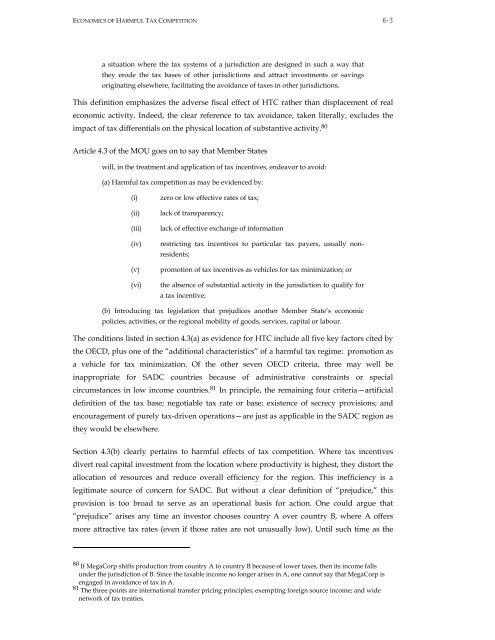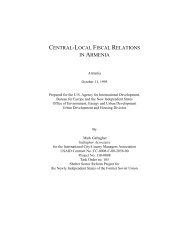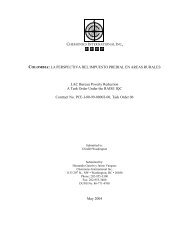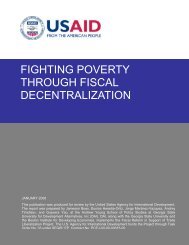Effectiveness and Economic Impact of Tax Incentives in the SADC ...
Effectiveness and Economic Impact of Tax Incentives in the SADC ...
Effectiveness and Economic Impact of Tax Incentives in the SADC ...
You also want an ePaper? Increase the reach of your titles
YUMPU automatically turns print PDFs into web optimized ePapers that Google loves.
ECONOMICS OF HARMFUL TAX COMPETITION 6-3<br />
a situation where <strong>the</strong> tax systems <strong>of</strong> a jurisdiction are designed <strong>in</strong> such a way that<br />
<strong>the</strong>y erode <strong>the</strong> tax bases <strong>of</strong> o<strong>the</strong>r jurisdictions <strong>and</strong> attract <strong>in</strong>vestments or sav<strong>in</strong>gs<br />
orig<strong>in</strong>at<strong>in</strong>g elsewhere, facilitat<strong>in</strong>g <strong>the</strong> avoidance <strong>of</strong> taxes <strong>in</strong> o<strong>the</strong>r jurisdictions.<br />
This def<strong>in</strong>ition emphasizes <strong>the</strong> adverse fiscal effect <strong>of</strong> HTC ra<strong>the</strong>r than displacement <strong>of</strong> real<br />
economic activity. Indeed, <strong>the</strong> clear reference to tax avoidance, taken literally, excludes <strong>the</strong><br />
impact <strong>of</strong> tax differentials on <strong>the</strong> physical location <strong>of</strong> substantive activity. 80<br />
Article 4.3 <strong>of</strong> <strong>the</strong> MOU goes on to say that Member States<br />
will, <strong>in</strong> <strong>the</strong> treatment <strong>and</strong> application <strong>of</strong> tax <strong>in</strong>centives, endeavor to avoid:<br />
(a) Harmful tax competition as may be evidenced by:<br />
(i) zero or low effective rates <strong>of</strong> tax;<br />
(ii) lack <strong>of</strong> transparency;<br />
(iii) lack <strong>of</strong> effective exchange <strong>of</strong> <strong>in</strong>formation<br />
(iv) restrict<strong>in</strong>g tax <strong>in</strong>centives to particular tax payers, usually non-<br />
residents;<br />
(v) promotion <strong>of</strong> tax <strong>in</strong>centives as vehicles for tax m<strong>in</strong>imization; or<br />
(vi) <strong>the</strong> absence <strong>of</strong> substantial activity <strong>in</strong> <strong>the</strong> jurisdiction to qualify for<br />
a tax <strong>in</strong>centive;<br />
(b) Introduc<strong>in</strong>g tax legislation that prejudices ano<strong>the</strong>r Member State’s economic<br />
policies, activities, or <strong>the</strong> regional mobility <strong>of</strong> goods, services, capital or labour.<br />
The conditions listed <strong>in</strong> section 4.3(a) as evidence for HTC <strong>in</strong>clude all five key factors cited by<br />
<strong>the</strong> OECD, plus one <strong>of</strong> <strong>the</strong> “additional characteristics” <strong>of</strong> a harmful tax regime: promotion as<br />
a vehicle for tax m<strong>in</strong>imization. Of <strong>the</strong> o<strong>the</strong>r seven OECD criteria, three may well be<br />
<strong>in</strong>appropriate for <strong>SADC</strong> countries because <strong>of</strong> adm<strong>in</strong>istrative constra<strong>in</strong>ts or special<br />
circumstances <strong>in</strong> low <strong>in</strong>come countries. 81 In pr<strong>in</strong>ciple, <strong>the</strong> rema<strong>in</strong><strong>in</strong>g four criteria—artificial<br />
def<strong>in</strong>ition <strong>of</strong> <strong>the</strong> tax base; negotiable tax rate or base; existence <strong>of</strong> secrecy provisions; <strong>and</strong><br />
encouragement <strong>of</strong> purely tax-driven operations—are just as applicable <strong>in</strong> <strong>the</strong> <strong>SADC</strong> region as<br />
<strong>the</strong>y would be elsewhere.<br />
Section 4.3(b) clearly perta<strong>in</strong>s to harmful effects <strong>of</strong> tax competition. Where tax <strong>in</strong>centives<br />
divert real capital <strong>in</strong>vestment from <strong>the</strong> location where productivity is highest, <strong>the</strong>y distort <strong>the</strong><br />
allocation <strong>of</strong> resources <strong>and</strong> reduce overall efficiency for <strong>the</strong> region. This <strong>in</strong>efficiency is a<br />
legitimate source <strong>of</strong> concern for <strong>SADC</strong>. But without a clear def<strong>in</strong>ition <strong>of</strong> “prejudice,” this<br />
provision is too broad to serve as an operational basis for action. One could argue that<br />
“prejudice” arises any time an <strong>in</strong>vestor chooses country A over country B, where A <strong>of</strong>fers<br />
more attractive tax rates (even if those rates are not unusually low). Until such time as <strong>the</strong><br />
80 If MegaCorp shifts production from country A to country B because <strong>of</strong> lower taxes, <strong>the</strong>n its <strong>in</strong>come falls<br />
under <strong>the</strong> jurisdiction <strong>of</strong> B. S<strong>in</strong>ce <strong>the</strong> taxable <strong>in</strong>come no longer arises <strong>in</strong> A, one cannot say that MegaCorp is<br />
engaged <strong>in</strong> avoidance <strong>of</strong> tax <strong>in</strong> A.<br />
81 The three po<strong>in</strong>ts are <strong>in</strong>ternational transfer pric<strong>in</strong>g pr<strong>in</strong>ciples; exempt<strong>in</strong>g foreign source <strong>in</strong>come; <strong>and</strong> wide<br />
network <strong>of</strong> tax treaties.











